Drinking Water Protection
- Drinking Water Protection Home
- About Us
- A-Z Index of Contaminants in Water
- Community Public Water Supply
- Drinking Water Grants and Loans
- Drinking Water Institute
- Drinking Water in Schools and Child Cares
- Drinking Water Revolving Fund
- Laws and Rules
- Noncommunity Public Water Supply
- Source Water Protection
- Water Operator and Certification Training
- Drinking Water Protection Contacts
Related Topics
- Annual Reports
- Drinking Water Risk Communication Toolkit
- Drinking Water Protection External Resources
- Fact Sheets
- Forms
- Invisible Heroes Videos: Minnesota's Drinking Water Providers
- Noncom Notes Newsletter
- Sample Collection Procedures (videos, pictures, written instructions)
- Waterline Newsletter
Related Sites
- 10 States Standards
- Clean Water Fund
- Health Risk Assessment – Guidance Values and Standards for Water
- Minnesota Well Index
- Water and Health
- Wells and Borings
Environmental Health Division
Woodbury removing PFAS from Drinking Water with Temporary Treatment Facility and moving forward with plans for Permanent Plant
From the Winter 2022-2023 Waterline
Quarterly Newsletter of the Minnesota Department of Health Public Water Supply Unit, Waterline
A complete list of feature stories can be found on the Waterline webpage.
The issue of perfluorochemicals in groundwater has been vexing residents and municipalities in the Twin Cities, particularly Washington County in the eastern part of the metropolitan area.
Dubbed “forever chemicals,” the substances went by different names and acronyms and are now under the umbrella term of per- and polyfluoroalkyl substances (PFAS). Household and industrial products, PFAS substances include stain repellents, lubricants, and fire suppressants. The 3M Company began making PFAS at a facility in Cottage Grove in the 1940s and historically disposed of PFAS wastes in four east metro locations, the source of identified PFAS impacts in Washington County groundwater.
The state of Minnesota and east-metro communities have coordinated efforts with 3M on water quality monitoring, disposal site remediation, and drinking water treatment solutions. In February of 2018 3M and the state reached an agreement for 3M to pay approximately $700 million towards drinking water treatment and potential PFAS mitigation efforts in the east metro area.
One of the affected communities is Woodbury, which has a population of about 75,000. In 2017 the Minnesota Department of Health established health standards for specific PFAS parameters and, with subsequent revisions, have to date issued health risk advisories on nine of Woodbury’s 19 municipal wells. The city proactively took those wells out of service and explored its options.
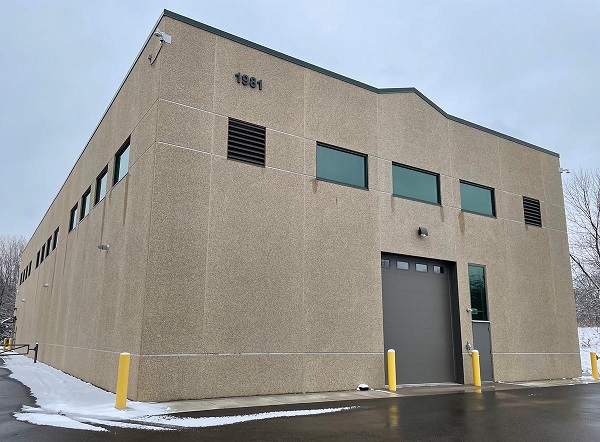
Woodbury's temporary treatment plant
Woodbury water background and temporary facility
Woodbury had performed limited water treatment (the addition of chlorine and fluoride) at its wells, which fed directly into the distribution system, producing more than 32 million gallons per day. Ranging in depth from 380 to 540 feet, the wells draw from the Jordan aquifer.
To deal with the PFAS situation, Woodbury made short- and long-range plans for a water treatment facility. In 2020, a temporary plant was constructed near the intersection of Tower Drive and Valley Creek Road in the central part of the city.
Woodbury had purchased land on this site in the early 1970s with thoughts of someday constructing a water treatment facility. Jim Westerman, the assistant public works director for Woodbury, said the city probably didn’t anticipate the growth that would take place over the next half-century. A centralized treatment facility to handle the city’s current population would have overwhelmed the site. However, a short-term plant was manageable. The site is within the city’s main well field, one that has the highest detections of PFAS. “Geographically, this was the spot to do it,” Westerman said.
The 9,500-square-foot facility originally treated water from four of the affected wells, numbers 4, 6, 7, and 17. Anticipating additional wells receiving health advisories, the city left room on the northwest portion of the building to bring in more filters and add capacity. When another four filters were added to the existing 12 in 2022, Wells 3 and 5 – which had subsequently received health advisories – were brought in to the treatment process. The plant now treats six of the nine wells with health advisories. The other three wells with health advisories currently remain out of service.
Although the facility has a capacity of around 5.7 million gallons per day (MGD), Westerman says that not all the water that passes through may be treated. “In coordination with the MPCA [Minnesota Pollution Control Agency] and DNR [Department of Natural Resources], this was designed to be a blending plant,” he explained. “We will bring more water here than we can treat at one time.” The plant has bypass mechanisms to allow for blending treated and untreated water. Westerman understands that, although their water now meets all health requirements, anticipated upcoming advisories may require altering the blending scenarios or treatment of all the water.
The treatment facility uses pressure filters, each with a diameter of 10 feet, filled with granular-activated carbon (GAC) to adsorb natural organic compounds and remove PFAS. Adsorption is the physical and chemical process of removing a substance, such as PFAS, from a liquid or gas through its attachment to a solid treatment surface. Activated carbon is an effective adsorbent because it is highly porous and provides a large surface area to which contaminants may adsorb. (One teaspoon of GAC has the same surface area for treatment as half a football field.)
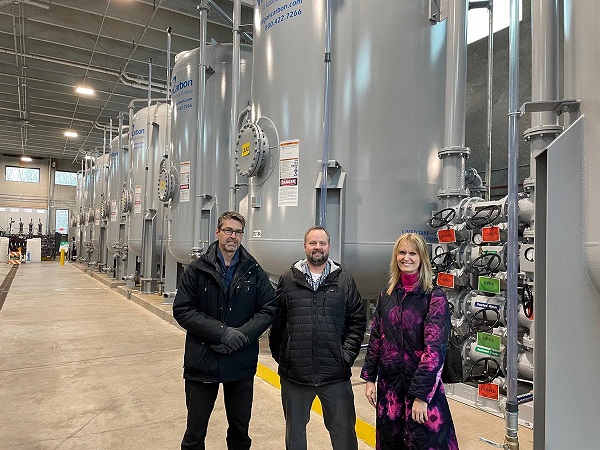
Jim Westerman and Jason Egerstrom from the city of Woodbury with Alycia Overbo of MDH in front of the GAC filters
The treatment involves a lead-lag system with the vessels split into eight pairs. Incoming water is split evenly between the pairs depending on operational needs. The water passes through each pair in series, first through the lead vessel and then the lag vessel. The use of two vessels provides a high level of protection with the lag vessel ensuring the removal of the contaminants to the lowest feasible level.
When the media is replaced, one of the options is for the old media to be taken to one of a limited number of disposal sites in the country to have the PFAS, under high temperatures, desorbed from the carbon media and the carbon-fluorine bonds destroyed. Standard landfills aren’t sufficient because of the possibility of the leaching of forever chemicals. Westerman thinks the filter media will last up to two-and-a-half years before it requires replacement. They have not yet had a change-out at the original plant.
The temporary facility will operate until a permanent plant, anticipated to be mostly financed by funds available from the 3M settlement, is constructed in the next estimated five years.
Permanent Water Treatment Facility
Last year the city purchased land south of Hargis Parkway and east of Radio Drive for a permanent facility to be located about three-and-a-half miles south of the current temporary plant. A massive project, the permanent plant will have a capacity of 32 MGD and require the installation of 14 miles of transmission lines to carry water from its Tamarack, East, and South well fields, the city’s three well fields. The South well field, located near the site of the permanent plant, is currently expanding with the construction of Wells 20 and 21. Well 20 is anticipated to be in service by early 2023 and Well 21 by early 2024.
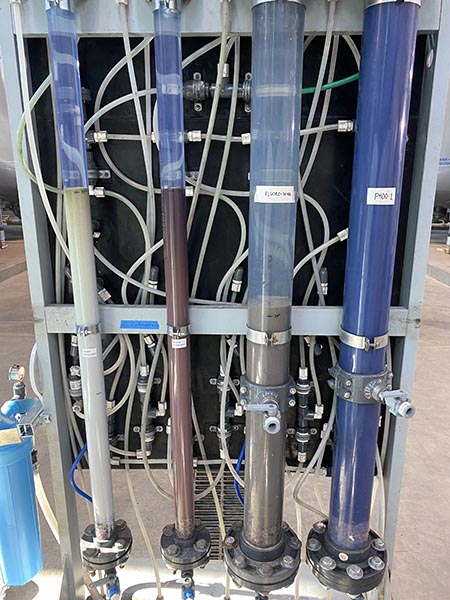
Above: A skid for the pilot testing being done at the temporary treatment plant. The testing is done to determine a media type for the permanent plant and to see if pre-treatment will be needed.
Below: Jim Westerman points to one of the media being considered.
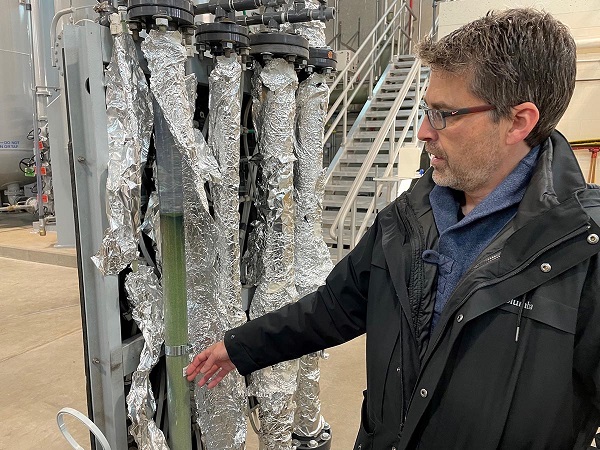
The new permanent water treatment plant will continue to have pressure filters although the city is conducting pilot tests to determine the type of media to be used in the pressure filters. Pilot testing for Woodbury’s effort has three phases. The first was done in a laboratory in Ohio, where water from Woodbury wells was sent. Phase II was performed on a pre-treatment skid in the temporary plant. Westerman explained that the studies are needed both to select a media type and to determine if pre-treatment is necessary.
Phase III will use water from both the Tamarack (location of the temporary facility) and South well fields (the one near the site of the permanent plant). The two-location phase of the pilot is to assist in evaluating water quality differences in the aquifer and the impact it may have on the treatment media. Water quality differences such as iron and manganese content could affect the filter media.
Westerman acknowledged the intricacies of a project that will take years to complete and that will have an impact of the citizens of Woodbury for decades. "This is going to take some time, but we have a great team of utility experts here working on this around the clock."
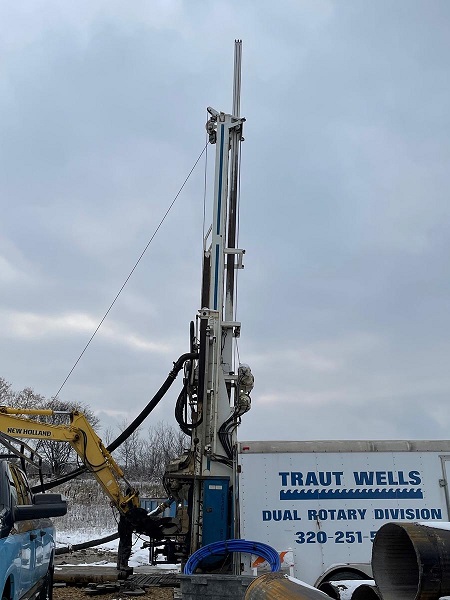
Well 21, being drilled near the site of the permanent plant.
Other Minnesota PFAS Treatment Facilities
Under different agreements and arrangements than the February 2018 settlement, other cities have received money from 3M. They include the east-metro suburb of Oakdale. 3M conducted a pilot study using GAC filters to remove PFAS and eventually built a facility to treat the water from two of Oakdale’s wells.
Bemidji also received money from 3M to cover maintenance and operating costs of a treatment facility to remove PFAS